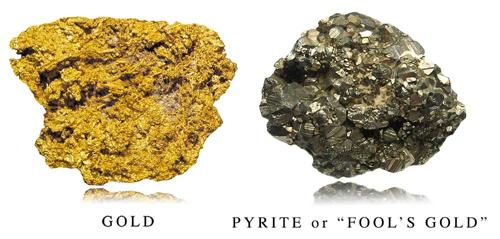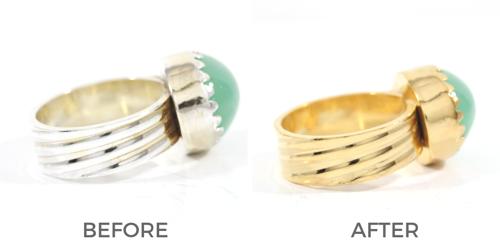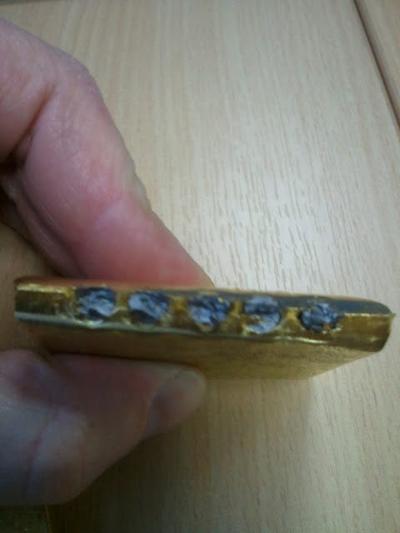
Unleashing the Value: Pawning Snap-on Tools at Pawn Shops
Many pawn shops pay top dollar for good condition tools and equipment.

Gold is among the most valuable and prized commodities in the world. Gold has served as a store of value and symbolized wealth, power, status, and fine taste for thousands of years dating back to the early Egyptians. Today, gold is commonly used for jewelry, coins, bullion, and electronics. Gold foil is even used to cover many valuable space satellites.
The high price of gold means that many imitations exist. With imitations such as gold leaf and gold plating, it is easy to tell the differences between real gold, but other imitations such as tungsten-filled gold bars are becoming increasingly difficult to detect. Modern fake gold could potentially shake confidence in the gold market - it is important that you understand the risks and learn how to detect fake gold.
In this post, we will cover the dynamics of fake gold, and how you can become an educated buyer of gold. Read more about how pawn shops value gold in our prior post.
Many forms of imitation gold exist. These forms are relatively easy to detect, and they are commonly found in artwork and jewelry.

Pyrite, also known as fool’s gold,
features a metallic luster and pale brass-yellow hue giving it a similar resemblance to gold. Pyrite is cheap and does not share
many of gold’s desirable properties.
Pyrite is not commonly found in jewelry. Pyrite often features sharp edges and corners.

Gold leaf, also called metal leaf,
is a very thin sheet of gold or metal that is applied to surfaces to give them
the appearance of gold. Gold leaf contains very little actual gold, so often it is not very valuable.
Gold leaf is often used on statues and frames. Artists typically add gold leaf to objects by applying a sticky bonding agent that holds the gold leaf to the surface. Gold leaf can fade when it is stored in outdoor climates.

Plated gold is a very thin layer of gold that is bonded to another metal. Plated gold is typically not worth much money because the gold content is so little. Typically plated gold thickness is measured using a term called "microns."
Low-quality plated gold does not pass the nitric acid scratch test. High-quality plated gold can often pass the nitric acid scratch test.
Over the last couple of decades, very sophisticated fake gold has made its way into the markets. In most cases, the fake
gold is in the form of gold bars filled or salted
with tungsten metal.
Gold and tungsten have very similar properties. Gold has a density of 19.32 grams per cubic centimeter, and tungsten has a density of 19.35 grams per cubic centimeter. The similar densities mean that counterfeiters can fill gold bars with tungsten, a much cheaper metal, and fool potential gold buyers into thinking they are buying pure gold.
Tungsten rods

In 2012 fake gold salted with tungsten hit stores in NYC. At the time an ounce of gold was worth $1,750, while an ounce of Tungsten was worth about $360. One gold buyer bought $100,000 of bars and later found tungsten after drilling into them.
What makes [it] so devious is a real gold bar is purchased with the serial numbers and papers, then it is hollowed out, the gold is sold, the tungsten is put in, then the bar is closed up.- Ti-Hua Chang, Fox News New York

Reuters later reported that at least 1,000 one-kilogram fake gold bars had been identified.
The fakes are getting better. They're beating the magnet test, the weight test. Nowadays, gold needs to be tested [in] several ways, including scratch testing or cutting into the metal, even if it means ruining the piece. Unfortunately, most of my customers intend to reclaim their jewelry and don’t want it damaged.- Anonymous pawnbroker in an interview with Thermo Fisher
The methods below will help you identify most fake gold. You can conduct many of these tests at home with common household items.
It is important to note that these tests will not detect high-quality fakes salted with tungsten as mentioned above. While reports of identifying high-quality fake gold bars are rare, you should be aware that high-quality fakes exist. The only way you can tell for sure that a gold bar is not fake is by drilling into it or melting it down. The fake market seems to target larger bars rather than coins and one-ounce bars.
You can examine gold with a loupe or magnifying glass to check for different colors and worn areas. Fake gold will show variations in the color near worn-down areas. Be sure to clean your gold with water and mild dish soap before inspecting it.
Gold is not magnetic, so it should not respond to a strong magnet. Many cheaper metal fillers such as steel are magnetic.
Density is one of the hardest aspects of gold to fake. You can check the gold’s density by submerging it in water and measuring the displacement.
24k solid gold has a density of 19.32 grams per cubic centimeter. 18k and 14k gold have densities of about 15.6 grams per cubic centimeter and 13.1 grams per cubic centimeter, respectively. It is important to note that there is more variance for non-pure gold because the alloys can vary.
Gold is very dense, so it often feels much heavier than it appears. You should use a jewelry scale precise to 0.1 grams to determine the exact weight of your gold. Verify the gold weight with paperwork and stamps on the gold.
Look for markings and indentations on your gold. Most gold is marked with 10k, 14k, 18k, 20k, 22k, or 24k. Be aware that fake can include fake stamps, so this test is not a guarantee that your gold is real.
Rub your gold on a black stone so it leaves a visible trace of the metal. Next, apply nitric acid to the metal on the black stone. Real gold will not react to the nitric acid, while imitation gold will dissolve.
Next, apply nitrohydrochloric acid (also called aqua regia which is 75% nitric acid and 25% hydrochloric acid) to the gold on the black stone. Real gold will dissolve.
Pure gold will not leave any noticeable marks on your skin when you wear it for an extended time. Cheap imitation gold can leave a black, blue, or green residue on your skin.
Take a piece of unglazed ceramic tile and scratch your gold on it. Real gold will leave a faint gold mark, while fake gold will leave other non-gold colors.
Apply a few drops of household vinegar to your gold. Real gold will not change color. Imitation gold will change color.
Jewelry pawn shops have experts in-house who can test and analyze your gold. Use Pawn Shop Map’s tool to find jewelry pawn shops near you.
You should contact the US Secret Service if you believe you have found fake gold. The US Secret Service is in charge of investigating counterfeit money and precious metals. The US Secret Service handled the cases discussed in the section above.
💬 Be the first to leave a comment

Many pawn shops pay top dollar for good condition tools and equipment.

Learn how to sell your good condition designer sunglasses to pawn shops

Learn how you can exchange Christmas gifts at pawn shops for cash

Learn how to get the most money at pawn shops for your rare Pokémon Cards.

Many pawn shops still buy and sell DVDs and DVD players. Learn how much money pawn shops will offer.

Pawn shops are an essential part of the economy. Learn how you can start a profitable pawn shop in your local region.